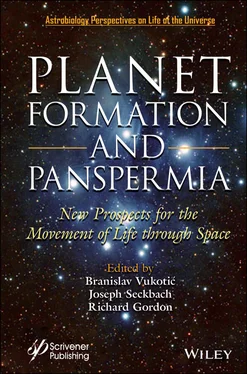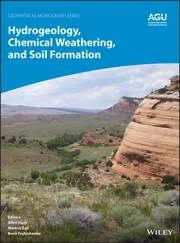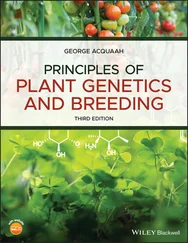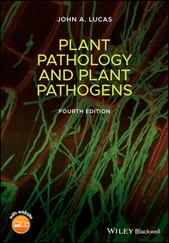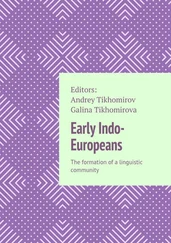Planet Formation and Panspermia
Здесь есть возможность читать онлайн «Planet Formation and Panspermia» — ознакомительный отрывок электронной книги совершенно бесплатно, а после прочтения отрывка купить полную версию. В некоторых случаях можно слушать аудио, скачать через торрент в формате fb2 и присутствует краткое содержание. Жанр: unrecognised, на английском языке. Описание произведения, (предисловие) а так же отзывы посетителей доступны на портале библиотеки ЛибКат.
- Название:Planet Formation and Panspermia
- Автор:
- Жанр:
- Год:неизвестен
- ISBN:нет данных
- Рейтинг книги:3 / 5. Голосов: 1
-
Избранное:Добавить в избранное
- Отзывы:
-
Ваша оценка:
- 60
- 1
- 2
- 3
- 4
- 5
Planet Formation and Panspermia: краткое содержание, описание и аннотация
Предлагаем к чтению аннотацию, описание, краткое содержание или предисловие (зависит от того, что написал сам автор книги «Planet Formation and Panspermia»). Если вы не нашли необходимую информацию о книге — напишите в комментариях, мы постараемся отыскать её.
Audience
Planet Formation and Panspermia — читать онлайн ознакомительный отрывок
Ниже представлен текст книги, разбитый по страницам. Система сохранения места последней прочитанной страницы, позволяет с удобством читать онлайн бесплатно книгу «Planet Formation and Panspermia», без необходимости каждый раз заново искать на чём Вы остановились. Поставьте закладку, и сможете в любой момент перейти на страницу, на которой закончили чтение.
Интервал:
Закладка:
All rights reserved. No part of this publication may be reproduced, stored in a retrieval system, or transmitted, in any form or by any means, electronic, mechanical, photocopying, recording, or otherwise, except as permitted by law. Advice on how to obtain permission to reuse material from this title is available at http://www.wiley.com/go/permissions.
Wiley Global Headquarters111 River Street, Hoboken, NJ 07030, USA
For details of our global editorial offices, customer services, and more information about Wiley products visit us at www.wiley.com.
Limit of Liability/Disclaimer of WarrantyWhile the publisher and authors have used their best efforts in preparing this work, they make no representations or warranties with respect to the accuracy or completeness of the contents of this work and specifically disclaim all warranties, including without limitation any implied warranties of merchantability or fitness for a particular purpose. No warranty may be created or extended by sales representatives, written sales materials, or promotional statements for this work. The fact that an organization, website, or product is referred to in this work as a citation and/or potential source of further information does not mean that the publisher and authors endorse the information or services the organization, website, or product may provide or recommendations it may make. This work is sold with the understanding that the publisher is not engaged in rendering professional services. The advice and strategies contained herein may not be suitable for your situation. You should consult with a specialist where appropriate. Neither the publisher nor authors shall be liable for any loss of profit or any other commercial damages, including but not limited to special, incidental, consequential, or other damages. Further, readers should be aware that websites listed in this work may have changed or disappeared between when this work was written and when it is read.
Library of Congress Cataloging-in-Publication Data
ISBN 978-1-119-64039-4
Cover image: Courtesy of NASA
Cover design by Russell Richardson
Set in size of 11pt and Minion Pro by Manila Typesetting Company, Makati, Philippines
Printed in the USA
10 9 8 7 6 5 4 3 2 1
Preface
The panspermia hypothesis dates back to the works of ancient philosophers. In the 1800s, organics in meteorites were considered by the Swedish chemist Jacob Berzelius [1.3] [1.4] and later German physician Hermann E. Richter [1.15] speculated on the possibility of life transport by meteors. Lord Kelvin [1.9], discussed the possibility of panspermia in his Presidential Address to the British Association for the Advancement of Science. At the beginning of the next century, Swedish physicist/chemist Svante August Arrhenius (1908) presented his book on the panspermia theory [1.2]. There is a long history from before this time through the last century of claims of finding life in meteorites [1.6]. Astronomical sciences also developed significantly during this period to the point where we can observe gravitational waves from merging black holes, which was hardly imaginable just a few decades ago, and visualize black holes. With the discovery of many exoplanets astrobiology has matured as a scientific discipline. A tentative discovery of the intergalactic meteor particle in 2007 [1.1] and recent discoveries of an anomalous object ‘‘Oumuamua [1.11] and comet 2I/Borisov [1.8], that appear to have visited us from outside the Solar system, point out that our planet and its host star may not be an isolated island, in an otherwise lifeless universe. They are likely to exchange matter with the other stars from their vicinity as probably is the case with other stellar systems too, perhaps containing life. There is currently a bias that any such panspermia, if they exist, are prokaryotes [1.13] [1.16] or rugged, microscopic Eukaryotes [1.14].
In addition to transporting the physical bodies of microorganisms, another important aspect is the transport of biological information about these living systems. After all, the evolution of life on Earth is about altering the genetic code, either by natural or artificial means. Given that the organic matter, the building blocks for living organisms, is omnipresent in the universe, the aforementioned information might in some way be considered as the essence of life, at least in our current genocentric view of life [1.5]. The aspect of sending just the information signal in order to spread life is investigated in the visionary sci-fi novel “His Master’s Voice” by Polish writer Stanislaw Lem, first published in 1968 [1.10]. Contemporary with the beginning radio SETI searches [1.18], this offered a convergence point between sending and receiving SETI signals and the panspermia hypothesis. Information panspermia was later born in 2005 with the work of Vahe Gurzadyan [1.7].
In times when a number of exciting new discoveries are made and the new ones seem to be just around the corner, the millenia old panspermia hypothesis has not yet matured into a full fledged theory and some of its aspects might still not have been envisioned. Along the lines of scientific falsificationism, we can consider that no evidence against panspermia are found to date and that much of the controversy still remains [1.12]. The search is even more active in the opposite direction but still there is an evident lack of convincingly non-terrestrial microorganisms on Solar system bodies other than Earth. The recent experiments with micro-organisms exposed to space conditions at the International Space Station offer accumulating evidence that these organisms can withstand the harsh conditions of open space for long periods of time while preserving their biological potential. Even more, there are mounting concerns that human made space vehicles can spread life from our biosphere to other bodies of the Solar system, the most recent one being that the Israeli space mission that transported tardigrades to the Moon [1.17].
While panspermia is related to microorganisms and small scale processes on one end, on the other end, the transport of material depends on environmental conditions in galaxies. The evolution of galaxies depends on the interaction of galaxies within galaxy clusters and the overall evolution of matter in the universe. The galaxies are the main building blocks of our universe, analogous to cells in a human body. The stars and their planets are condensed from the clouds of galactic gas and dust that are rich in organics. The process of planetary formation is at the middle among the above stated scales that are relevant for panspermia. Starting from planetary formation, studies can go in either direction, to larger or smaller scales, to investigate phenomena that could spread life.
This collection of chapters incorporates studies from biology, astronomy and geology that investigate the possibility of panspermia, with most of them directly investigating phenomena related to the process of planetary formation. The processes described in these chapters permit the panspermia hypothesis, but empirical confirmation is still lacking at the level of our current knowledge. The basic aim of this book is to provoke readers to contemplate their respective research fields that are related to panspermia. For that matter it presents the basics of panspermia but also the advanced studies in the research fields presented. The chapters are comprehensible on a student level but at the same time they might be very interesting to experienced researchers. Possibly, some of them are already working on current and future space missions that may offer an empirical vindication of extra-terrestrial life transfer through the vastness of space.
Branislav Vukotić
Richard Gordon
Читать дальшеИнтервал:
Закладка:
Похожие книги на «Planet Formation and Panspermia»
Представляем Вашему вниманию похожие книги на «Planet Formation and Panspermia» списком для выбора. Мы отобрали схожую по названию и смыслу литературу в надежде предоставить читателям больше вариантов отыскать новые, интересные, ещё непрочитанные произведения.
Обсуждение, отзывы о книге «Planet Formation and Panspermia» и просто собственные мнения читателей. Оставьте ваши комментарии, напишите, что Вы думаете о произведении, его смысле или главных героях. Укажите что конкретно понравилось, а что нет, и почему Вы так считаете.
